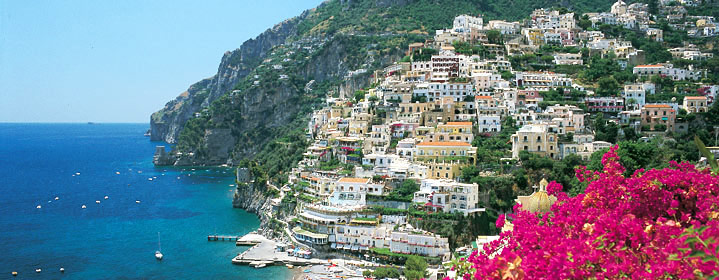

Positano is a charming village of 3700 inhabitants which lies on the Amalfi Coast
between three valleys called Pertuso, Comune and Paipo.
According to the tradition, Positano was founded by the inhabitants of Paestum who had fled from their homes,
sacked by the invaders around the 10th century. The town was built around the ancient Benedictine Abbey of S. Vito. It soon became a major maritime powerm representing serious cause for concern even to the powerful Republic of Amalfi..
The town lies on the southern side of the Lattari Mountains. Gently sloping down to the sea, terraces are constructed along the rock spurs of M.Comune and Mount Sant'Angelo a Tre Pizzi, right in the middle of the gulf between Punta Germano to the west and Capo Sottile to the east.
Because of its outstanding panoramic postion and mild climate, togehter with its picturesque architecture and the lush surrounding countryside, Positano, has become one of the most popular resorts on the Amalfi Coast. Its simple white house with their characteristic vaulted roofs, standing out amid the myriad colours of splendid gardens or shaded by exotic palm trees, its historical beauties and the spectacular blue sea have constituted an irresistible attraction since the turn of the century, when tourism began to develop in this area.
The winding Via Pasitea, the main road which leads towards Piazza Flavio Gioia with its exceptional view, runs rigth across the town , also crossed by picturesquestepped lanes. The beauty of this area was reconised as early as Roman times, when a magnificent villa was built, of which interesting reamins still survive. In the piazza stands the Parish Church of of S. MariaAssunta, easily identifiable by its majestic majolica-covered dome and the seperate campnile, which features an outstanding medieval bas- relief portraying sea creatures and a fox. The Parish Church is built on the remains of an older church; significent fragments of the mosaic decorations of the original building are still visible in the interior, which is divided into a nave and two aisles by sturdy pillars.
On leaving the church, the visitor can follow the seaward direction down to Marina Grande, the large beach ringed by cliffs. There is an unrivalled view from here, across the gulf as far as the two furthermost headlands.
There are two other eaches to the west of the town (Fornillo) and to the east ( La Porta, Ciumicello and Arienzo). Fascinating relics of the local community life in the Palaeolithic and Mesolithic eras (various household objects and weapons) hav ebeen found in a cave near one of these beaches (La Porta).
Positano is also known for its fashion and even window shoppign is an experience in this quaint and unspoilt town.Positano’s elegant shop windows are full of displays of brightly coloured robes, bikinis, bags, and Bermuda shorts all made in cool linen, gauze and cotton. It is home to skilled tailors and cobblers and is the perfect place to pick up hand crafted sandals, made to measure whilst you wait, unique fashions and even a glamorous wedding dress.
Nowadays, this town is one of the most well-known seaside-resorts on the Amalfi Coast
and it is especially popular with artists from all over the world.
They appreciate its houses, the majority white, clustering in picturesque confusion,
on the seaward slope of the steep hill.
Many painters, indeed, came to Positano for just a few days and stayed there for the rest of their lives.
From this charming town it is easy to reach the other famous places of the area:
the National Road 163 takes to Sorrento on one side and Amalfi, Ravello, Vietri and Salerno on the other side.
Moreover, it is worth visiting the so-called "Chiesa Madre",
the main church whose majolica dome is visible from any spot of Positano.
And at the sunset the fishing boats take the sea with great lanterns on the bow:
they fish anchoves and cuttle-fish. Then, the nightlife of Positano is absolutely unique
and you cannot miss enjoying a good dish of fish in one of the restaurants on the beach.
| BACK |